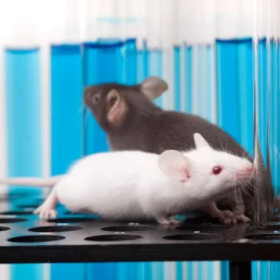In biomedical research and preclinical dementia research there has historically been a tendency towards sole inclusion of males, particularly in preclinical animal studies. The reason has often centred on the potential variability of females relating to fluctuations in hormones which could confound the data. But could this bias towards studying males account for poor translation of preclinical to clinical research? In this blog I discuss the importance of including both sexes in preclinical research, and why this might significantly advance progress in dementia research.
The issue of whether to include both sexes in preclinical research is not new, as it has been debated for several decades with little progress. Historically there has been a male bias in research looking at the causes of brain diseases but also in the testing of treatments and therapies. This significant male bias has been prevalent in preclinical research on dementia, as well as other diseases, despite the fact that women are more likely to develop dementia than men. From the research which has looked at sex differences, we now know that there are differences not only in how particular diseases develop and progress, but also in how drugs are metabolised and the nature of drug side effects.
There have been some significant changes recently which suggest that a consensus in the scientific community has been reached; female inclusion should be default as part of good experimental design. This might seem obvious to many people, so why was this not already the case, and why has it taken so long to get here? One reason for this male bias has been attributed to the nature of designing preclinical animal studies where there is a strong focus on minimising sources of variability. For example, animal strains are bred over many generations reducing genetic variation; animals within a group will be the same age typically from the same litter; and often only males will be selected as subjects to remove sex as a variable.
These reasons for only including males in preclinical studies are compounded by the aim of minimising the number of animals required as outlined by the 3Rs principles (Replacement, Reduction, and Refinement); an ethical framework for animal-based research, which is embedded in law to regulate scientific procedures that involve animals. “Reduction” refers to using methods which minimise the number of animals required in an experiment, or maximising the amount of information obtained per animal. It is likely that many preclinical animal studies have failed to include females because of researchers concerned with violating this principle; including females would mean having to double the number of animals, right? It is true that researchers shouldn’t be using more animals than is necessary to obtain statistically meaningful results, but experiments that fail to include both sexes and then account for it during analysis can lead to data which lack a meaningful conclusion, particularly for certain diseases such as those which lead to dementia, which may predominantly affect women. This too would be classed as using more animals than necessary because these studies bias the knowledge base. That aside, the doubling of sample size when including females might be a misconception for statistical reasons because when sex is used as a variable the experimental design changes in addition to how the data would be statistically analysed. For example, changing from a complete randomised design to a factorial design alters what is being compared and may require a slight increase in sample size but not a doubling of it.

Most behavioral studies using mice, use male mice only. That is because most researchers fear hormones get in the way; estrous cycles might cause data variability.
The inclusion of both sexes in preclinical animal research is not without challenges. For example, cognitive tests are often used in rodent studies of dementia to understand both the neural correlates of memory function and to assess the amnestic properties of new drugs. These tests involve the use of apparatus and sometimes particular objects, all of which can be scent marked by rodents. Scent from other animals, particularly from those which are of the other sex or which are not cage-mates, can have an impact on animal behaviour and confound the data. It is therefore important to clean apparatus and surfaces between testing each animal, which is not always easy depending on the nature of the equipment. This example demonstrates that there can be a number of procedural challenges which may arise from inclusion of both sexes in experiments, but they should not be used as a reason for failing to include females as subjects.
Despite the issue of male bias in preclinical research, there has been an increasing focus on the need for change, in part due to the replication crisis, but also due to the poor translation in the preclinical to clinical research pipeline which has impeded the discovery of treatments and therapies, particularly in dementia research.
We are beginning to see these changes become embedded in all aspects of preclinical research. Members of the Animal Welfare Ethical Review Boards at research institutions are consistent in querying animal projects which fail to either include both sexes, or provide strong justification for not doing so.
Similarly, many journals endorse the ARRIVE guidelines (Animal Research: Reporting of in vivo Experiments) which are designed to improve the reporting of animal research. One of the items on the list includes information on the sex of the animals, with authors required to state they have included this information in their manuscript. Journal editors and reviewers can then query if there is not sufficient information or justification provided. Some journals, such as the Journal of the American Medical Association, have also updated their “Instructions for Authors” to require reporting of sex or justification, such as studying a disease which only affects males or females.
The final drive for change is coming from research funders. In March 2022, UKRI (UK Research and Innovation) announced that the Medical Research Council will require sex to be specified in grant applications for projects that involve animals, as well as human and animal tissues and cells. Single-sex studies can be proposed with justification, but use of both sexes will be considered the default.
A shift towards inclusion of both males and females in preclinical research can only lead to more robust and reproducible science which in turn will drive progress in areas such as dementia research, where development of treatments and therapies needs to be prioritised.

Dr Kamar Ameen-Ali
Author
Dr Kamar Ameen-Ali is a Lecturer in Biomedical Science at Teesside University & Affiliate Researcher at Glasgow University. In addition to teaching, Kamar is exploring how neuroinflammation following traumatic brain injury contributes to the progression of neurodegenerative diseases that lead to dementia. Having first pursued a career as an NHS Psychologist, Kamar went back to University in Durham to look at rodent behavioural tasks to completed her PhD, and then worked as a regional Programme Manager for NC3Rs.

 Print This Post
Print This Post




